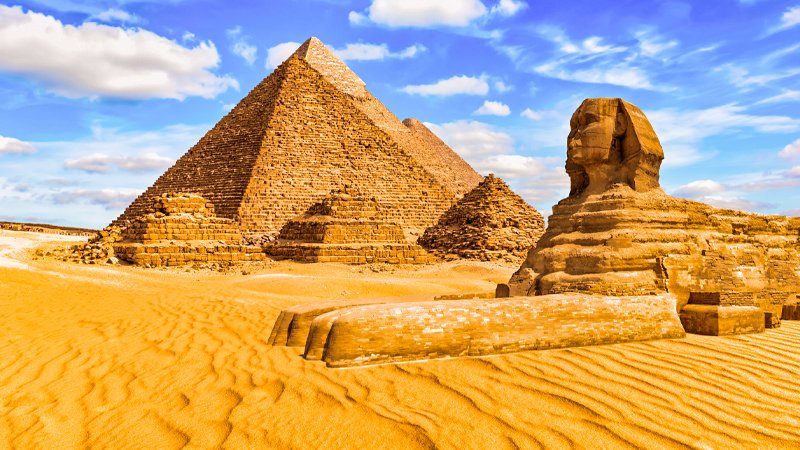The Great Sphinx of Giza stands as one of the most enigmatic and iconic monuments in the world. Nestled on the Giza Plateau near Cairo, Egypt, this colossal statue has fascinated historians, archaeologists, and tourists alike for centuries. As a sentinel guarding the ancient pyramids, the Sphinx is not just a symbol of ancient Egyptian grandeur but also a testament to the engineering prowess of a civilization that thrived over 4,500 years ago. In this comprehensive article, we will delve deep into the history, significance, and mysteries of the Great Sphinx of Giza, offering valuable insights for travelers planning to visit this extraordinary monument.
The History of the Great Sphinx
The history of the Great Sphinx of Giza is shrouded in mystery and debate. Traditionally, it is believed that the Sphinx was constructed during the reign of Pharaoh Khafre (c. 2558–2532 BC) of the Fourth Dynasty. Khafre is also credited with building the second of the three pyramids on the Giza Plateau. The Sphinx, carved from a single limestone ridge, features the body of a lion and the head of a human, which is thought to represent Khafre himself. However, some theories suggest that the Sphinx predates Khafre and was merely restored during his reign. The lack of inscriptions detailing its construction has led to various hypotheses about its origins, including suggestions that it might be much older, dating back to a pre-dynastic era.
Architectural Marvel: Design and Construction
The Great Sphinx is an architectural marvel, measuring approximately 73 meters (240 feet) in length and 20 meters (66 feet) in height. Its construction involved precise carving from the natural limestone bedrock of the Giza Plateau. The body of the Sphinx, with its elongated form and detailed musculature, showcases the ancient Egyptians’ skill in large-scale sculpture and their understanding of anatomy. The face, although eroded over millennia, retains a sense of majesty and power, with its serene expression and headdress resembling that of a Pharaoh. The monument’s alignment with the pyramids and the Nile further emphasizes its significance, potentially serving as a guardian of the royal necropolis and a symbol of royal power and divine protection.
Theories and Mysteries Surrounding the Sphinx
The Great Sphinx is enveloped in numerous theories and mysteries that continue to intrigue scholars and enthusiasts. One of the most debated topics is the erosion patterns observed on the Sphinx. Some researchers argue that the deep weathering and erosion on its body indicate prolonged exposure to heavy rainfall, which suggests that the Sphinx could be much older than traditionally believed, possibly dating back to a time when the region experienced a wetter climate. Additionally, the purpose of the Sphinx remains speculative. While it is widely accepted as a royal monument, some theories propose that it might have served as an astronomical marker or a representation of a deity. The lack of conclusive evidence fuels ongoing debates and adds to the allure of this ancient structure.
The Sphinx in Ancient Egyptian Religion and Mythology
In ancient Egyptian religion and mythology, the Sphinx held significant symbolic value. It was often associated with the sun god Ra and was seen as a protective figure. The lion’s body symbolized strength and power, while the human head represented wisdom and intelligence, creating a fusion of qualities deemed essential for the Pharaoh’s role as both a ruler and a deity. The Sphinx’s positioning, facing east towards the rising sun, underscores its solar association. In various myths, the Sphinx was believed to be a guardian of sacred spaces, protecting the realm of the living and the afterlife. This religious and symbolic importance further enhances its status as a monumental achievement of ancient Egyptian culture.
Restoration and Preservation Efforts
Over the millennia, the Great Sphinx has undergone numerous restoration and preservation efforts to combat the ravages of time and environmental factors. The earliest known restoration dates back to the New Kingdom, around 1400 BC, when Pharaoh Thutmose IV cleared the Sphinx from encroaching sand and erected a stela between its paws, known as the Dream Stele. In more recent history, the Sphinx has been subjected to modern conservation techniques aimed at addressing issues like erosion, pollution, and structural instability. These efforts are crucial in preserving the monument for future generations and maintaining its status as a global heritage site. Despite these challenges, the Sphinx remains a resilient symbol of ancient Egypt’s enduring legacy.
Visiting the Great Sphinx: Practical Information
For travelers planning to visit the Great Sphinx, there are several practical considerations to ensure a memorable experience. The Sphinx is part of the Giza Necropolis, which includes the famous pyramids and other significant archaeological sites. Visitors can access the site via Cairo, with numerous tours and transportation options available. It is advisable to visit early in the morning or late in the afternoon to avoid the midday heat and large crowds. Additionally, hiring a knowledgeable guide can enhance the visit by providing in-depth historical context and insights into the monument’s significance. Respecting the site’s rules and guidelines is essential to preserving its integrity for future visitors.
Conclusion
The Great Sphinx of Giza stands as a timeless emblem of ancient Egyptian ingenuity, spirituality, and artistry. Its imposing presence on the Giza Plateau continues to captivate and inspire people from all walks of life. Whether viewed as a guardian of the pyramids, a representation of royal power, or a subject of endless fascination and debate, the Sphinx remains a testament to the enduring legacy of one of history’s most remarkable civilizations. For travelers and enthusiasts of ancient history, the Great Sphinx of Giza offers an unparalleled glimpse into the past and an unforgettable experience that transcends time.

